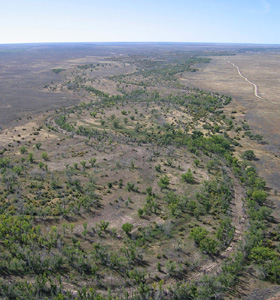
|
Landscapes of the
Central Great Plains
Chapter VI
Flint Hills and Red Hills
James S. Aber and Susan W. Aber
Emporia State University Emeritus
|
VI.1 Introduction
Permian bedrock is the foundation of the Red Hills and Flint Hills (see geologic maps and landscape maps). The Flint Hills are supported by lower Permian strata consisting of alternating limestone and shale layers of predominately marine origin. The Red Hills, on the other hand, are underlain by lower and upper Permian red beds of mainly terrestrial origin. In the subsurface, these strata include layers of salt and gypsum precipitated by evaporation of high-salinity marine water as the Permian inland sea dried up episodically. These landscape regions are dominated by water erosion, both physical washing and chemical solution at the surface and underground. Thus, the landforms include various hills, buttes, escarpments, terraces, ravines and valleys, as well as karst features, namely sinkholes, springs, and caves.
VI.2 Red Hills
Red color of the bedrock, soil, and stream sediment is the most obvious defining feature of this landscape region in south-central Kansas. The Red Hills are bounded to the east by the Wellington subsection of the Arkansas River Lowlands and to the north and west by the High Plains. The Red Hills, also known as the Gyp Hills or Cimarron Breaks, exhibit a colorful and rugged topography unlike any other landscape in Kansas.
In contrast to the adjacent, relatively flat regions, the Red Hills display substantial relief as a consequence of widespread stream and gully erosion. Lowest elevations are along the Chikaskia River valley about 1400 feet (425 m) in southeastern Kingman County; highest elevations reach 2400 feet (730 m) in southeastern Meade County. Much of the Red Hills consists of ravines, gullies, small channels and valleys that display intricate drainage patterns. Isolated buttes and mesas stand 100 to 200 feet (30-60 m) above the surrounding terrain, for example southwest of Medicine Lodge. In many ways, the Red Hills resemble parts of the Colorado Plateau or Arizona Painted Desert.
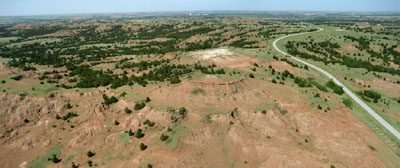
| Overview of typical Red Hills terrain. Red beds of the Flower-pot Shale are eroding to form badlands in the foreground. The light-colored butte near scene center is capped with gypsum of the Blaine Formation. View northeast toward Medicine Lodge, central Barber County. Panorama assembled from two kite airphotos (Aber and Aber 2009).
| |
The Red Hills derive their color from upper Permian bedrock that consists of poorly consolidated shale, siltstone and sandstone, which are stained rust-red by iron oxide. These sediments were deposited as terrestrial alluvium in an ancient desert that extended across what is now the southern Great Plains region from the Ouachita Mountains in eastern Oklahoma to the Ancestral Rockies in New Mexico and Colorado.

| Upper portion of the Sangre de Cristo Formation, a thick sequence of red beds exposed in the Culebra Range, south-central Colorado. These strata accumulated as alluvial fans on the flanks of the Ancestral Rocky Mountains during the early Permian.
|
Interbedded with the red strata are beds of dolomite and soluble minerals, namely gypsum, anhydrite and salt, deposited from evaporating sea water. Several lower and upper Permian formations crop out in the Red Hills, of which the Blaine Formation is most prominent. It contains thick layers of white gypstone and salt (subsurface). The gypstone beds are sufficiently resistant to erosion in the relatively dry climate of the region, so they form conspicuous rim- and cap-rocks, particularly in western Barber County.
Underground solution of thick salt and gypsum layers has led to collapse of the surface in many places. Big Basin and Little Basin are well-known sinkholes in Clark County. Big Basin occupies about one square mile (2.6 km2) and is more than 100 feet (30 m) below the surrounding upland. Little Basin is equally deep but much smaller in area. A perennial pool, known as St. Jacobs Well, is located in Little Basin. The Englewood-Ashland Lowland in southern Clark County is thought to be a still larger example of surface collapse by underground solution (Wilson 1978).

| Large sinkholes in upper Permian red beds in the western portion of the Red Hills. Big Basin (left) is the large depression in the center distance. Only the north half of the basin is visible in this view. Little Basin (right) in the foreground. Clark County; kite aerial photographs.
| 
|
Groundwater has dissolved the soluble beds and created more than 400 caves in the Red Hills, the most known caves of any landscape region in Kansas (Young and Beard 1993). Most of these caves are young, small, short-lived features, however, as continued solution causes them to collapse within a few millennia. This region spanning south-central Kansas and adjacent Oklahoma hosts many bats and is among the most important in the United States for bat biodiversity (Sparks et al. 2011). Another famous feature was the natural bridge south of Sun City in western Barber County; it broke down in 1962, although human intervention may be to blame. These examples suggest that geomorphic change is relatively rapid in the Red Hills due to a combination of subsurface dissolution and surface erosion of soluble and poorly consolidated rock.

| Collapse of a Red Hills natural bridge in western Barber County, caused by erosion of an intermittent stream, as documented with ground photographs taken from the same vantage point. 1955 (left) and 1962 (right). Adapted from Charlton and Merriam (2003).
| 
|
Surface water is relatively scarce in the Red Hills. Smaller streams are intermittent; larger perennial streams include the Cimarron River, Medicine Lodge River, and Chikaskia River. Two, small, man-made reservoirs are Clark State Fishing Lake and Lake Coldwater; no large reservoirs have been constructed in this region. Likewise, groundwater is not abundant apart from alluvial aquifers in the larger river valleys. The scarcity of water resources has limited most land use to pasture and grazing.
In the subsurface, gypsum is mined near Sun City to produce drywall and other plaster products. Numerous oil and gas fields have been discovered beneath the Red Hills, especially in Barber County. Intensive drilling and development of oil fields has led to numerous small to moderate earthquakes in recent years, most likely because of injection of oil-field waste brine in deep disposal wells (Rubenstein 2022).
VI.3 Flint Hills
The Flint Hills, one of the most distinctive, picturesque, and best-known regions in Kansas, extends as a belt from the edge of the Glacial Hills southward to Oklahoma, a north-south distance about 175 miles (280 km). The widest portion, just south of the Kansas and Smoky Hill rivers is about 70 miles (110 km) across east-west, and the region tapers southward to only a few miles across at the Oklahoma border. Elevation ranges from below 920 feet (280 m) on the Kansas River in Wabaunsee County to above 1640 feet (500 m) on the Flint Hills crest in Chase, Greenwood, and Butler counties. These are the highest elevations in the eastern one-third of the state. Local topographic relief exceeds 300 feet (90 m) in many places.
The eastern margin of the Flint Hills is a steep, rugged escarpment that rises abruptly above the Osage Cuestas to the east. In contrast, the western side of the Flint Hills is a broad cuesta that slopes gradually downward toward the Smoky Hills and Arkansas River Lowlands. Thus the crest of the Flint Hills stands higher than terrain on either side. The Flint Hills are deeply dissected by numerous stream valleys. The northern and central Flint Hills are transected by the Blue, Kansas and Neosho-Cottonwood drainages which divide the uplands into several distinct segments. The southern Flint Hills, however, forms a continuous ridge along the divide between the Verdigris-Fall drainage to the east and Arkansas-Walnut basin to the west.
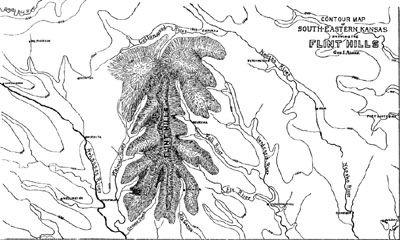
| Sketch map of southern Flint Hills, south of the Cottonwood River valley in east-central Kansas. The ridge-like crest of the Flint Hills forms the drainage divide between the Verdigris-Fall basin to the east and Arkansas-Walnut basin to the west. Adapted from Hayworth (1896).
| |

| Typical stone lines in the eastern Flint Hills. Stone lines are particularly distinctive in May as tallgrass greens up following April prairie burning. Near Dunlap, Morris County, Kansas. Kite aerial photograph.
|
The Flint Hills are underlain by lower Permian limestone and shale, and certain limestone layers appear as distinctive stone lines on the hill sides. These strata are arranged in repeated layers called cyclothems. The cyclothems of the Flint Hills are remarkably similar to upper Pennsylvanian cyclothems of the Osage Cuesta region, except that lower Permian cyclothems have prominent red-shale zones and lack sandstone, black shale, and coal that are common in Pennsylvanian cyclothems. Limestone beds toward the top of each cyclothem contain abundant chert (flint) in many places.
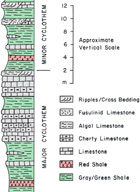
| Schematic model (left) for lower Permian cyclothems of the Flint Hills region. Exposure of the Florence Limestone Member (right) displaying interbedded limestone, chert, and shaly limestone. Weathering has concentrated chert fragments in residual red soil at the surface. Scale pole marked in feet,
| 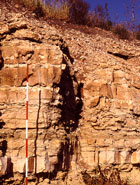
|
Chert is resistant to chemical weathering, so when limestone dissolves at the surface chert nodules accumulate as a residual layer in the soil. This chert creates an armor-like surface that protects the Flint Hills from erosion and supports the relatively high elevation and rugged topography of the region.
Some limestone layers lack chert, are relatively homogeneous, and form thick beds that are ideal for quarrying dimension stone (Aber and Grisafe 1982). Several such limestone beds have been exploited since the nineteenth century and used for stone structures throughout the Flint Hills and beyond. For example, Alma and Marion are well known for their stone architecture. Among several such layers, the Cottonwood and Fort Riley limestone members are most important. Many famous buildings were constructed with these stones.
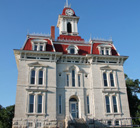
| Cottonwood Limestone architecture. Chase County Courthouse (left), one of the iconic symbols of the Flint Hills. Built in 1871-72 in a French Renaissance style, it is the oldest county courthouse still in use in Kansas. Atchison Post Office (right) built in 1890 in a Richardsonian Romanesque style of native stone imported from the Flint Hills.
| 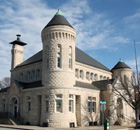
|
Thicker limestone units, especially the Barneston Limestone, have several zones with well-developed karst morphology as a result of underground limestone solution. Typical features include sinkholes, disappearing streams, numerous springs, and cave systems (Young and Beard 1993). Such features are especially common in central Butler County as well as southern Wabaunsee County (Savage 1879-80). Karst landscape is developed in connection with structural domes, upland drainage divides, entrenched stream valleys nearby, and lack of thick surficial cover (chert or loess). These factors in combination enhanced the conditions for vertical drainage of water into highly fractured and soluble rock (Aber 1992).

| Sinkhole (left) in Fort Riley Limestone; Kansas Academy of Science fall fieldtrip. This sink connects directly to Smith Cave in the subsurface. Entrance to Spring Cave (right), one of the few Flint Hills caves large enough to walk into. Both in central Butler County.
| 
|
During the course of downcutting, streams have left behind evidence of their former channels in the form of chert gravel deposits, named the Leon Gravel (Aber 1992), now situated on hill tops and high terraces. The Olpe Soil is an indicator for such gravels. In nearly all cases, downward stream erosion has been asymmetric, such that older terraces are located on only one side of the valley. For valleys running north-south, older terraces and chert gravels are located primarily on the western sides; valleys extending east-west have preserved terraces and chert gravels mainly on the northern sides. A similar pattern is found to the east across the Osage Cuestas, which suggests that regional crustal tilting may be responsible for streams gradually shifting toward the south and east as they became entrenched (Aber 1997).
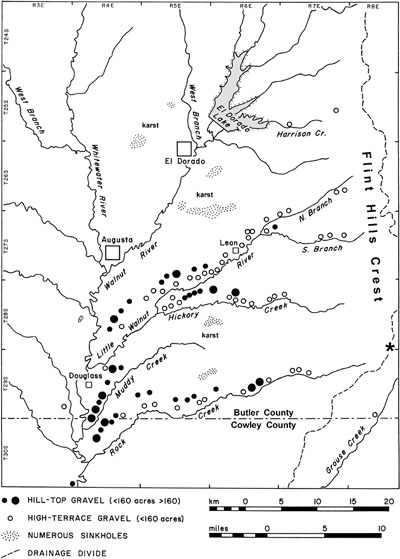
| Map of the southern Flint Hills region showing zones with numerous sinkholes and chert gravel deposits on high terraces and hill tops. Asterisk indicates location of the Elk River Wind Farm. Adapted from Aber (1992).
| |
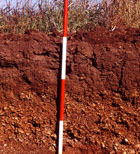
| Section in Olpe Soil on a drainage divide in southern Butler County. Leon Gravel in lower portion was deposited in a Neogene stream channel; upper portion is younger loess. Scale pole marked in feet.
|
Stream erosion in the Flint Hills has exploited weak zones in the bedrock, namely fracture zones, resulting in a linear network of valleys. Long, straight stream valleys, known as lineaments, coincide with fracture sets in surficial bedrock that reflect still deeper fractures within the basement rock of the region (Aber et al. 1997). Such lineaments may continue across adjacent landscape regions. Among the most prominent lineaments in eastern Kansas is the Neosho River valley that cuts northwest to southeast through the Flint Hills and Osage Cuestas. Groundwater is generally abundant in the Flint Hills, derived from thick limestone aquifers. Large springs and artesian wells are common, especially toward the western side.

| Fractures in Cottonwood Limestone revealed by low water in winter on lake margin. Such fractures in well-consolidated bedrock guide stream erosion at the surface and groundwater movement in the subsurface. Lake Kahola, Chase County, Kansas; kite aerial photograph. |

| Artesian well produces sulfur-rich water from the western side of the Flint Hills in Marion County.
|
The Flint Hills include the largest tract of tallgrass prairie that still exists in the United States. Owing to rocky soils and steep slopes, crop agriculture has been limited to narrow valleys, particularly in the eastern portion. Some crops are grown in thin loess soils that cap uplands in the western portion of the region. Cattle grazing is the primary land use, and ranchers employ controlled burning to maintain the prairie grasses (Hoy 1993).
Based on the relatively unmodified condition of the landscape, the Nature Conservancy has acquired considerable acreage, including the Flint Hills Tallgrass Prairie Preserve, Konza Prairie, and most of the Tallgrass Prairie National Preserve. The Flint Hills embody the archetype of the American prairie, and as such the region has become a destination for ecotourism and focal region for scientific research and restoration.
Given the topographic prominence of the Flint Hills, especially its eastern escarpment, the region has high potential for wind energy. Early in this century, two wind farms were constructed in Butler and Elk counties. In 2004, Governor Sebelius proposed the Heart of the Flint Hills Area, in which wind-farm development would be discouraged through voluntary restraint in order to protect the tallgrass prairie ecosystem.

| Elk River Wind Farm occupies the drainage divide at the crest of the Flint Hills near Beaumont in southeastern Butler County (see map above). Elevation exceeds 500 m here. Kite aerial photograph.
| |
The governor's decision followed intense debate involving land owners, local governments, energy developers, and numerous environmental organizations. The original moratorium area was relatively restricted in geographic coverage to that portion of the Flint Hills that preserved the most intact tallgrass habitat, was least altered by human activities, and had the greatest scenic beauty. Elk River and Caney River wind farms are situated to the south, outside the original Heart of the Flint Hills Area.

| A portion of the Caney River Wind Project located on the Americus Limestone cuesta of the Flint Hills escarpment west of Howard in Elk County. Vestas V90, 1.8 MW turbines; towers stand 262 feet tall, and rotor diameter is 295 feet. This wind farm began operation in 2012 (Aber and Aber 2016).
|
In 2011, Governor Brownback more than doubled the extent of the exclusion zone, enclosing a area approximately 60 miles (100 km) east-west by 170 miles (275) km north-south that extends into other landscape regions well beyond the Flint Hills. Since then, no additional construction of wind farms has taken place in the expanded exclusion zone.
The Flint Hills generally are perceived as little modified by human activity, but there is, in fact, considerable development. Oil and gas are produced from structures along the buried Nemaha Uplift and Humboldt Fault zone, particularly in the El Dorado Oil Field. The region is criss-crossed with major highways, pipelines and electrical transmission lines. Large and small reservoirs have been constructed, and military training takes place at Fort Riley. Radio and telephone towers cluster on the higher ridges. Last, but not least, trees and woodlands are encroaching on the grassland (Applegate et al. 2003; Peterson et al. 2004). The reality is that few unspoiled prairie vistas remain.

| Typical rural Flint Hills vista in central Chase County. In spite of the largely natural character of this autumn prairie scene, encroachment of trees along Rock Creek and its tributary valleys is evident. Kite aerial photograph.
|
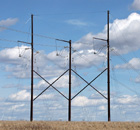
| Electrical transmission lines and substations detract from the scenic vistas in many parts of the Flint Hills.
| 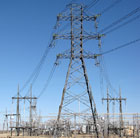
|
 Return to beginning.
Return to beginning.
 Combined references.
Combined references.

 Return to Landscapes table of contents.
Return to Landscapes table of contents.
All text and images © by the authors (2022).






 Return to beginning.
Return to beginning. Combined references.
Combined references.
 Return to Landscapes table of contents.
Return to Landscapes table of contents.